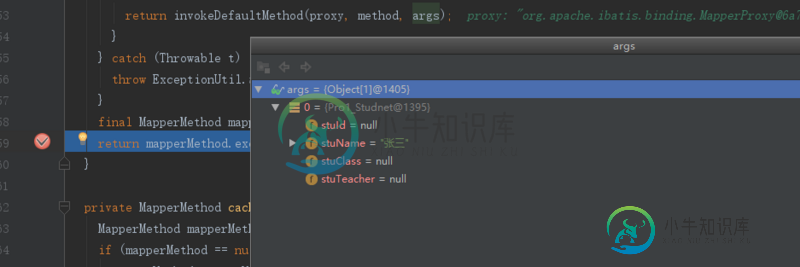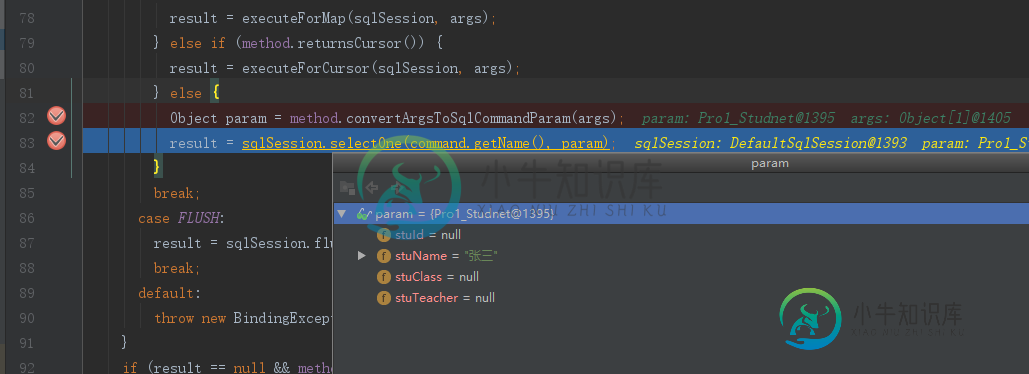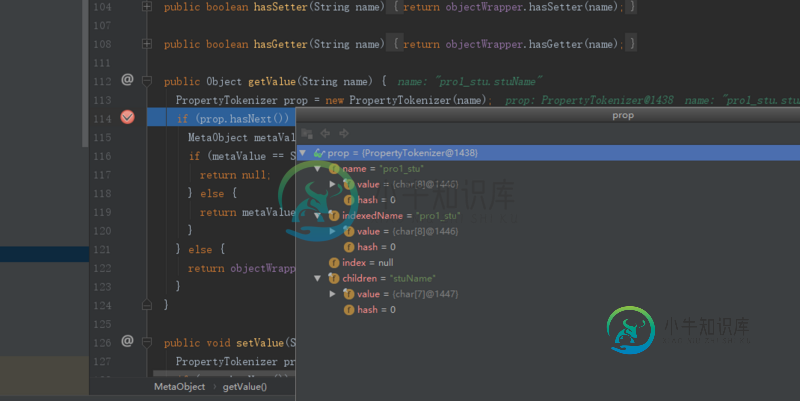使用Mybatis遇到的there is no getter异常
在使用mybatis的时候有时候会遇到一个问题就是明明参数是正确的,但是还是会提示There is no getter XXX这个异常,但是一般的解决办法是在mapper里面添加@Param注解来完成是别的,那么为什么会遇到这个问题呢?
以下为举例代码:
Mapper层代码
public interface Pro1_Mapper {
Pro1_Studnet insertStu(Pro1_Studnet pro1_studnet);
}
实体类代码
public class Pro1_Studnet {
private String stuId;
private String stuName;
private String stuClass;
private String stuTeacher;
public String getStuId() {
return stuId;
}
public void setStuId(String stuId) {
this.stuId = stuId;
}
public String getStuName() {
return stuName;
}
public void setStuName(String stuName) {
this.stuName = stuName;
}
public String getStuClass() {
return stuClass;
}
public void setStuClass(String stuClass) {
this.stuClass = stuClass;
}
public String getStuTeacher() {
return stuTeacher;
}
public void setStuTeacher(String stuTeacher) {
this.stuTeacher = stuTeacher;
}
}
Main方法
public static void main(String[] args) {
Logger logger = null;
logger = Logger.getLogger(Pro1_Main.class.getName());
logger.setLevel(Level.DEBUG);
SqlSession sqlSession = null;
try {
sqlSession = study.mybatis.MybatisUtil.getSqlSessionFActory().openSession();
Pro1_Mapper pro1_Mapper = sqlSession.getMapper(Pro1_Mapper.class);
Pro1_Studnet pro1_studnet =new Pro1_Studnet();
pro1_studnet.setStuName("张三");
Pro1_Studnet pro1_studnet1 =pro1_Mapper.insertStu(pro1_studnet);
System.out.println(pro1_studnet1.getStuClass());
sqlSession.commit();
} finally {
sqlSession.close();
}
}
XML文件
<?xml version="1.0" encoding="utf-8"?>
<!DOCTYPE mapper
PUBLIC "-//mybatis.org//DTD Mapper 3.0//EN"
"http://mybatis.org/dtd/mybatis-3-mapper.dtd">
<mapper namespace="study.szh.demo.project1.Pro1_Mapper">
<resultMap type="study.szh.demo.project1.Pro1_Studnet" id="pro1_stu">
<result property="stuId" column="stu_id"/>
<result property="stuName" column="stu_name"/>
<result property="stuClass" column="stu_class"/>
<result property="stuTeacher" column="stu_teacher"/>
</resultMap>
<select id="insertStu" parameterType="study.szh.demo.project1.Pro1_Studnet" resultMap="pro1_stu">
SELECT * from pro_1stu where stu_name = #{pro1_studnet.stuName};
</select>
</mapper>
如果执行上述的代码,你会发现mybatis会抛出一个异常:
There is no getter for property named 'pro1_studnet' in 'class study.szh.demo.project1.Pro1_Studnet'
很明显就是说pro1_studnet这个别名没有被mybatis正确的识别,那么将这个pro1_studnet去掉呢?
尝试将xml文件中的pro1_studnet去掉然后只保留stuName,执行代码:
张三
这表明程序运行的十分正常,但是在实际的写法中,还有如果参数为String也会导致抛出getter异常,所以此次正好来分析下
分析
mybatis是如何解析mapper参数的
跟踪源码你会发现在MapperProxy的invoke处会进行入参:
@Override
public Object invoke(Object proxy, Method method, Object[] args) throws Throwable {
try {
if (Object.class.equals(method.getDeclaringClass())) {
return method.invoke(this, args);
} else if (isDefaultMethod(method)) {
return invokeDefaultMethod(proxy, method, args);
}
} catch (Throwable t) {
throw ExceptionUtil.unwrapThrowable(t);
}
final MapperMethod mapperMethod = cachedMapperMethod(method);
return mapperMethod.execute(sqlSession, args);
}
注意此处的args,这个参数就是mapper的入参。

那么mybatis在这里接收到这个参数之后,它会将参数再一次进行传递,此时会进入到MapperMethod的execute方法
public Object execute(SqlSession sqlSession, Object[] args) {
//省略无关代码
case SELECT:
if (method.returnsVoid() && method.hasResultHandler()) {
executeWithResultHandler(sqlSession, args);
result = null;
} else if (method.returnsMany()) {
result = executeForMany(sqlSession, args);
} else if (method.returnsMap()) {
result = executeForMap(sqlSession, args);
} else if (method.returnsCursor()) {
result = executeForCursor(sqlSession, args);
} else {
Object param = method.convertArgsToSqlCommandParam(args);
result = sqlSession.selectOne(command.getName(), param);
}
break;
case FLUSH:
result = sqlSession.flushStatements();
break;
default:
throw new BindingException("Unknown execution method for: " + command.getName());
}
if (result == null && method.getReturnType().isPrimitive() && !method.returnsVoid()) {
throw new BindingException("Mapper method '" + command.getName()
+ " attempted to return null from a method with a primitive return type (" + method.getReturnType() + ").");
}
return result;
}
因为在xml文件里面使用的是select标签,所以会进入case的select,然后此时会进入到Object param = method.convertArgsToSqlCommandParam(args); 在这里args还是Stu的实体类,并未发生变化
随后进入convertArgsToSqlCommandParam方法,然后经过一个方法的跳转,最后会进入到ParamNameResolver的getNamedParams方法,
public Object getNamedParams(Object[] args) {
final int paramCount = names.size();
if (args == null || paramCount == 0) {
return null;
} else if (!hasParamAnnotation && paramCount == 1) {
return args[names.firstKey()];
} else {
final Map<String, Object> param = new ParamMap<Object>();
int i = 0;
for (Map.Entry<Integer, String> entry : names.entrySet()) {
param.put(entry.getValue(), args[entry.getKey()]);
// add generic param names (param1, param2, ...)
final String genericParamName = GENERIC_NAME_PREFIX + String.valueOf(i + 1);
// ensure not to overwrite parameter named with @Param
if (!names.containsValue(genericParamName)) {
param.put(genericParamName, args[entry.getKey()]);
}
i++;
}
return param;
}
}
此时注意hasParamAnnotation这个判断,这个判断表示该参数是否含有标签,有的话在这里会在Map里面添加一个参数,其键就是GENERIC_NAME_PREFIX(param) + i 的值。像在本次的测试代码的话,会直接在return args[names.firstKey()];返回,不过这不是重点,继续往下走,会返回到MapperMethod的execute方法的这一行result = sqlSession.selectOne(command.getName(), param);
此时的param就是一个Stu对象了。

继续走下去...由于mybatis的调用链太多,此处只会写出需要注意的点,可以在自己debug的时候稍微注意下。
BaseExecutor的createCacheKey的方法
@Override
public CacheKey createCacheKey(MappedStatement ms, Object parameterObject, RowBounds rowBounds, BoundSql boundSql) {
if (closed) {
throw new ExecutorException("Executor was closed.");
}
CacheKey cacheKey = new CacheKey();
cacheKey.update(ms.getId());
cacheKey.update(rowBounds.getOffset());
cacheKey.update(rowBounds.getLimit());
cacheKey.update(boundSql.getSql());
List<ParameterMapping> parameterMappings = boundSql.getParameterMappings();
TypeHandlerRegistry typeHandlerRegistry = ms.getConfiguration().getTypeHandlerRegistry();
// mimic DefaultParameterHandler logic
for (ParameterMapping parameterMapping : parameterMappings) {
if (parameterMapping.getMode() != ParameterMode.OUT) {
Object value;
String propertyName = parameterMapping.getProperty();
if (boundSql.hasAdditionalParameter(propertyName)) {
value = boundSql.getAdditionalParameter(propertyName);
} else if (parameterObject == null) {
value = null;
} else if (typeHandlerRegistry.hasTypeHandler(parameterObject.getClass())) {
value = parameterObject;
} else {
MetaObject metaObject = configuration.newMetaObject(parameterObject);
value = metaObject.getValue(propertyName);
}
cacheKey.update(value);
}
}
if (configuration.getEnvironment() != null) {
// issue #176
cacheKey.update(configuration.getEnvironment().getId());
}
return cacheKey;
}
当进行到这一步的时候,由于mybatis的类太多了,所以这里选择性的跳过,当然重要的代码还是会介绍的。
DefaultReflectorFactory的findForClass方法
@Override
public Reflector findForClass(Class<?> type) {
if (classCacheEnabled) {
// synchronized (type) removed see issue #461
Reflector cached = reflectorMap.get(type);
if (cached == null) {
cached = new Reflector(type);
reflectorMap.put(type, cached);
}
return cached;
} else {
return new Reflector(type);
}
}
注意MetaObject的getValue方法:
public Object getValue(String name) {
PropertyTokenizer prop = new PropertyTokenizer(name);
if (prop.hasNext()) {
MetaObject metaValue = metaObjectForProperty(prop.getIndexedName());
if (metaValue == SystemMetaObject.NULL_META_OBJECT) {
return null;
} else {
return metaValue.getValue(prop.getChildren());
}
} else {
return objectWrapper.get(prop);
}
}
这里的name的值是pro1_stu.stuName,而prop的属性是这样的:

这里的hasNext函数会判断这个prop的children是不是为空,如果不是空的话就会进入 get 方法,然后进入到如下的方法通过返回获取get方法。
所以当遍历到stuName的时候会直接return,
然后就需要注意Reflector的getGetInvoker方法,
public Invoker getGetInvoker(String propertyName) {
Invoker method = getMethods.get(propertyName);
if (method == null) {
throw new ReflectionException("There is no getter for property named '" + propertyName + "' in '" + type + "'");
}
return method;
}
这个propertyName就是pro1_studnet,而getMethods.get(propertyName);就是要通过反射获取pro1_studnet方法,但是很明显,这里是获取不到的,所以此时就会抛出这个异常。
那么为什么加了@param注解之后就不会抛出异常呢
此时就需要注意MapWrapper类的get方法。
@Override
public Object get(PropertyTokenizer prop) {
if (prop.getIndex() != null) {
Object collection = resolveCollection(prop, map);
return getCollectionValue(prop, collection);
} else {
return map.get(prop.getName());
}
}
在之前就说过,如果加了注解的话,map的结构是{"param1","pro1_studnet","pro1_studnet",XXX对象},此时由于prop的index是null,所以会直接返回map的键值为pro1_studnet的对象。
而在DefaultReflectorFactory的findForClass里面,由于所加载的实体类已经包含了Pro1_Student,随后在metaValue.getValue(prop.getChildren());的将stu_name传入过去,就可以了获取到了属性的值了。
以上就是本文的全部内容,希望对大家的学习有所帮助,也希望大家多多支持小牛知识库。
-
我在尝试使用iText编辑pdf文档时遇到以下异常。这个问题是非常零星的,就像有时它是工作的,有时它是抛出错误。 下面是我用来编辑的代码:
-
本文向大家介绍使用mybatis-plus的insert方法遇到的问题及解决方法(添加时id值不存在异常),包括了使用mybatis-plus的insert方法遇到的问题及解决方法(添加时id值不存在异常)的使用技巧和注意事项,需要的朋友参考一下 mybatis在持久层框架中还是比较火的,一般项目都是基于ssm。虽然mybatis可以直接在xml中通过SQL语句操作数据库,很是灵活。但正其操作都要
-
当我尝试运行SBT时,我得到以下消息:
-
问题内容: 我正在使用注释设置mybatis,并获得此有用的异常 org.apache.ibatis.binding.BindingException:MapperRegistry未知类型接口org.foo.Bar 谷歌搜索找不到任何东西,也没有用户指南。我想念什么? 问题答案: 好的,知道了-这是因为我正在使用XML文件进行配置,并且为映射器本身添加了注释-并且mybatis在使用XML配置时找
-
找不到指定的模型:User\u model Filename:/opt/lampp/htdocs/ci/system/core/Loader。php 电话号码:348 回溯: 文件:/opt/lampp/htdocs/ci/index。php行:315函数:需要一次 我试图改变名称,但它不工作......这个代码模型

